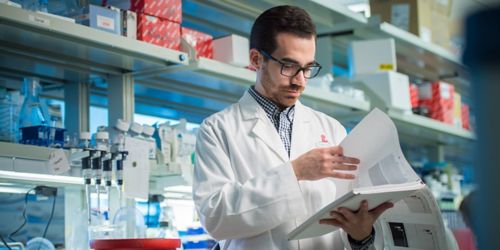St. Jude Family of Websites
Explore our cutting edge research, world-class patient care, career opportunities and more.
St. Jude Children's Research Hospital Home

- Fundraising
St. Jude Family of Websites
Explore our cutting edge research, world-class patient care, career opportunities and more.
St. Jude Children's Research Hospital Home

- Fundraising
Bringing your science out of the journal and into the world

Science contributes to societal progress by pushing the boundaries of knowledge. The scientific enterprise is an integral part of society and, as such, is largely dependent on public funding. As scientists, our role in society has granted us the recognition of being problem-solvers and trustworthy opinion-makers. But what happens when we forget of our part in society and just let our discoveries get lost in the realm of scientific literature and terminology? We surrender the most important trait we have: our credibility.
People's actions often rely less on science and more on opinions. Thus, we need to embrace our responsibility of communicating science in an accessible way to the public and to maintain a positive perception about it. We must, therefore, reinvent ourselves as effective communicators of our science, using storytelling to engage and incorporate the public into our scientific debates.
As communicators, we are the face of science. Our goal is not to change people's values or beliefs, but inspire positive feelings, increase awareness and make science and scientists more credible. Our means of communication cannot be through monologues, but rather through dialogues that allow scientists and the public to interact.
Bringing your science out of the journal and into the world can be nerve-racking for the unaccustomed science communicator. How do I explain to an audience that doesn't know what the immune system is what the role of mTORC1 is in T cell lineage commitment? Here are five tips in crafting your next science communication presentation:
1. Define your mission
When drafting a scientific paper or presentation, we typically focus on "the big discovery." When addressing a lay audience, forget about the big discovery and focus on why you are giving such a presentation and why your audience is interested in listening to you. As you begin your presentation, share what you hope to accomplish with it as this will give them a destination to search through your talk.
2. Connect with your audience
The most effective way of connecting with a lay audience is by building a personal connection. You can do so by making your scientific story relevant to you at a personal level: Why are you a scientist? Why do you study cancer? What makes the immune system fascinating to you? Sharing a personal story early on provides an immediate preview of the information you are about to give them.
3. Level the playing field
Science communication is about informing within a framework, so take the time to think about the context in which you are sharing your science and craft your story accordingly. Know who your audience is and the frame in which they find your science most relevant. Do not assume universal understanding — In general, you can think of lay audiences as people interested in science who are not particularly knowledgeable about the subject you are discussing. Use introductory statements to find common ground with your audience and impact statements to keep them interested and engaged.
4. Tell a story
Any good story has characters, a plot, and a climactic resolution; make sure your story has these three elements. The public is interested in the process, not in the publication, so keep it simple and exciting; use analogies to break down complex concepts. As you tell the story, emphasize common goals between you as a scientist and them as the public; this will fortify the human connection you started building at the beginning of the presentation and will keep the story relevant to your audience.
5. Offer a call-to-action
The goal of science communication is to raise public awareness, understanding, and engagement, so a call-to-action at the end of the presentation is critical in promoting more interactions between the public and scientists. With a call-to-action, the audience feels invigorated with your talk and capable of getting involved in the scientific discussion.
We have the responsibility of sharing our science with the world, a world that goes beyond our colleagues and competitors. No matter the context in which we share our science, we must present it as a neutral, factual, dynamic, relevant, and vital force that drives our everyday lives.






